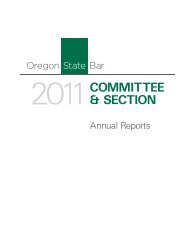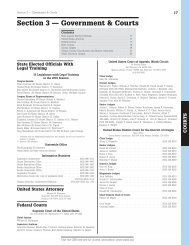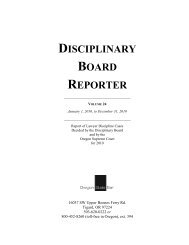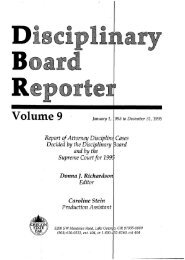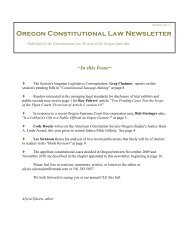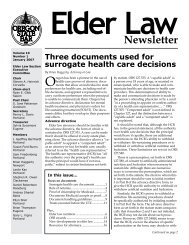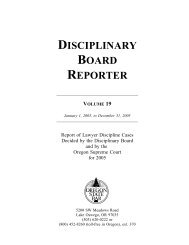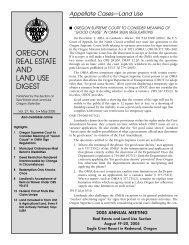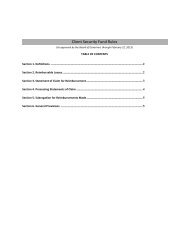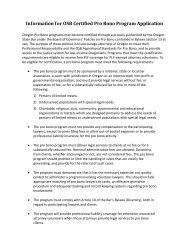Jackson v. Franklin Sports Gazette, Inc. Grading ... - Oregon State Bar
Jackson v. Franklin Sports Gazette, Inc. Grading ... - Oregon State Bar
Jackson v. Franklin Sports Gazette, Inc. Grading ... - Oregon State Bar
You also want an ePaper? Increase the reach of your titles
YUMPU automatically turns print PDFs into web optimized ePapers that Google loves.
Multistate Performance Test<br />
GRADING SUMMARY<br />
<strong>Jackson</strong> v. <strong>Franklin</strong> <strong>Sports</strong> <strong>Gazette</strong>, <strong>Inc</strong>.<br />
The <strong>Franklin</strong> <strong>Sports</strong> <strong>Gazette</strong> has been sued by baseball star Richard “Action” <strong>Jackson</strong> for allegedly<br />
violating his right of publicity. Applicants must draft a memo analyzing whether <strong>Jackson</strong> has a cause of<br />
action (COA) under <strong>Franklin</strong>’s right of publicity statute and whether the <strong>Gazette</strong> has any arguments to<br />
oppose that COA. Applicants should conclude that <strong>Jackson</strong> is not identifiable in the Photo, and that the<br />
<strong>Gazette</strong>’s use of the Photo could fall within the statute’s news reporting exemption.<br />
Whether <strong>Jackson</strong> Has a COA under <strong>Franklin</strong>’s New Right of Publicity Statute (60% total weight)<br />
A COA under the statute requires 1) use of the plaintiff’s persona, 2) appropriation of the persona for<br />
commercial or other advantage, 3) lack of consent, and 4) resulting injury.<br />
The key issue is use of <strong>Jackson</strong>’s persona. Presumably, commercial advantage, lack of consent,<br />
and injury will be easily established.<br />
Cases on the common law COA for appropriation of persona remain good law. (10% weight)<br />
The individual’s face need not be visible; distinctive clothing or other features may be<br />
enough for identification. Holt; Brant.<br />
Under § 62(b), <strong>Jackson</strong> is not “readily identifiable” in the Photo by the public. (30% weight)<br />
No part of his face or body can be identified.<br />
His clothing does not identify him—the second “0” on his uniform is visible, but four players<br />
had numbers ending in “0” that season, and six players now wear such numbers.<br />
<strong>Jackson</strong> is Caucasian, as are the other five players who wear numbers ending in “0”; when<br />
the Photo was taken, two other Caucasian players had numbers ending in “0.”<br />
The word “action,” <strong>Jackson</strong>’s nickname, in the ad is not sufficient to identify him. (20% weight)<br />
It is arguable that identifiability must be established by the Photo alone, without the ad’s text.<br />
This construction would favor the <strong>Gazette</strong>.<br />
The better argument is that here, “action” is a common noun, not a proper noun (e.g., “Get in<br />
with Action”), and thus there is no connection with Action <strong>Jackson</strong>.<br />
In sum, it is likely that <strong>Jackson</strong> is not identifiable and his complaint thus fails to state a COA.<br />
Whether the <strong>Gazette</strong>’s use of the Photo constitutes news reporting under § 62(d) (40% total weight)<br />
Miller, which predates § 62, permitted use of a news photo in a subscription ad as an ancillary<br />
use illustrating the magazine’s news coverage.<br />
The <strong>Gazette</strong>’s use of the Photo would likely be a permitted use under Miller.<br />
But <strong>Jackson</strong> could make a plausible argument that the use of his likeness and the word<br />
“action” could be deemed an endorsement by <strong>Jackson</strong> of the <strong>Gazette</strong>—not a permitted use.<br />
This is a closer case than Miller, where the plaintiff’s name was not cited in the ad.<br />
The language of § 62(d) creates uncertainty regarding ancillary uses. Is Miller still good law?<br />
§ 62(d) refers only to a news “account,” thus, a court could conclude that it is not as broad as<br />
the common law “news reporting” defense.<br />
However, § 62(d)’s reference to a use “in connection with any news … account” may lend<br />
support for uses which advertise the news medium itself.<br />
Applicants may come down either way on this issue—the point is that they recognize and<br />
grapple with the ambiguity in the statutory language. 20% weight should be allocated to the issue<br />
of whether Miller remains good law and the other 20% to the application of the law to the facts.<br />
11<br />
Not for Public Distribution



